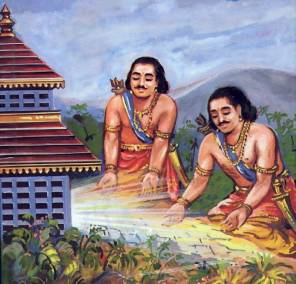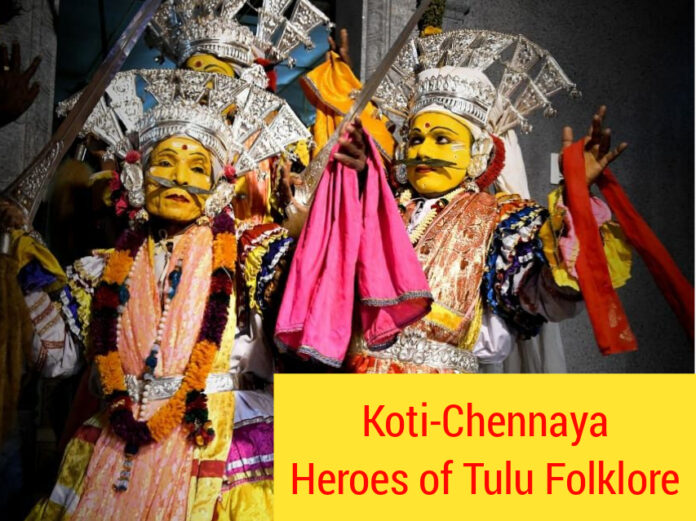[Note by the translator: The twin daivas of Koti and Chennaya are one of the most popular folk deities of Tulunadu. Along with other daivas or bhutas such as Kallurti, Bobbarya, Maisandaya, Alibhuta, Koragajja, etc., Koti-Chennaya get venerated in the length and breadth of the Tulu region. Numerous studies suggest that most daivas are reminiscent of the folk heroes of that name, who were subjected to oppression of different sorts to maintain the hierarchical status-quo of the traditional Tulunadu. When they became mayaka (or perished fighting that oppression), they started getting venerated. Being born in the Billava¹ caste, Koti-Chennaya were subjected to constant treachery and harassment, even though they came close to power centres. It is roughly estimated that the twin brothers lived in the seventeenth or the eighteenth century. The following story of Koti and Chennaya is a translation based on the story written by Shri Panje Mangesha Rao, an early litterateur in Kannada. Panje himself got several (Tulu) versions of the story – one of them from Hermann Moegling of the Basel Mission. Comparing and contrasting, he finally arrived at the following story in the early twentieth century.]
This is Part I of the 14 part Koti- Chennaya series
Long long ago, the Tulunadu was divided among several small dynasties. Bangas were ruling from one corner of the Tulu region. Another part was governed by the Chautas. Ajila dynasty was strong in another portion. Every village had a gurikara² as an administrator. Four to five such villages were under a Ballala, who looked after the administration. Many such Ballalas made up regions each of which was governed by Banga, Chowta, Ajila, Savantha, and such chiefs. One such Ballala was in Padumale; another one was in Panja and the third one, in Enmooru³.
One fine day, the Perumaalu Ballala of Padumale set out on a hunting expedition with his accomplices. While chasing a wild boar, a big, sharp thorn of kasarka(4) plant pierced into his feet, causing enormous pain. Even as his assistants were wondering what is to be done, he admonished “Why do you stare at me like that?! Call Boodi Bommaya of…”, before he could finish his words Ballala fell unconscious. No sooner did he faint than his servants rushed into the forest, prepared a wooden stretcher, and carried him to Boodi Bommaya on it.

The news of Ballala falling ill spread across Padumale. People wanting to render a helping hand tried several ways: they tried plucking out the thorn; they tried with mantra; they tried with a variety of medicines. Bommaya tried with his tricks; Ammanna Baidya tried with his treatments – but all in vain! Day by day, the pain simply increased and the ailment merely worsened. Ballala could neither eat nor sleep. Suffering from agony, he was clueless about what to do. People from around the place visited him and shed tears at his plight. One among them said slowly and hesitantly, “such sores used to be cured by our Sayina Baidya. Now he is blind. But his sister Deyi could do the job.” Another one added, “Yes, Deyi’s medications are effective. But how could she come now? She is pregnant and is expecting anytime!” “It is not even three months since her husband Kanthanna Baidya passed away”, said the third one. No sooner did Ballala hear about Deyi, than he ordered his servants to fetch her in his palanquin. They set off instantaneously.
Deyi saw the palanquin the servants of Perumaalu Ballala brought. She was not happy with the turn of events this indicated; yet, she could not deny helping the Ballala. Deyi collected the necessary medicines, herbs, coconuts, etc. and put them in the palanquin. The Bovis carried the palanquin to the Ballala.
In Padumale, the Ballala was impatiently looking for Deyi’s arrival, not really knowing if she agreed to treat him. In some time came Deyi! She got down from the palanquin and with evident modesty came and sat beside the Ballala. Ballala earnestly begged her, “Amma, Baiditi… please save my life! I came from the womb of my mother; now let me be reborn from your womb! I will honour you with rewards that you haven’t heard of; I will give you gifts that nobody has given!
Upon his request, Deyi started attending to him: she washed off the medicines on the wound applied by Ammanna Baidya; smeared it with medicines prepared by her; chanted the mystic mantra; cooled it off with the herbs she brought with her. With Deyi’s medication, day by day and hour by hour, Ballala recovered. He got his appetite back! He was unable to sleep for many days. Now, he could sleep too! He was the very same Ballala as before! Ballala and his family regarded Deyi Baiditi with great respect for the service she rendered. Meanwhile, some people were jealous at Baiditi, looking at this turn of events. One among these was the minister of Ballala, one Mallaya Buddhivantha.
Deyi saw that the Ballala was normal again. One day she said to him, “Ballala, I would like to return home. If you intend to gift me anything, please do so!”
“For sure you may go! However, Mallaya Buddhivantha isn’t here. I need to talk to him before I give you the gifts”, Ballala said.
“Oh, is it so?! You needed me when you were losing your life! Now you need Buddhivantha when I remind you of the gifts!” Deyi responded wryly and started off.
At this instance, Ballala’s wife sarcastically commented, “Huh! What an honour for saving his life!” Ballala heard this and called Deyi back. Ballala put a plate in her hand and said, “take this Deyi! These are for you, the Ole, Bugudi, Koppu, and Mooguti(5). All these are for you! Rest, I would give to your children”, he assured her. “I have a daughter, Kinnidaaru”, Deyi said. “Is she at home?” Ballala asked. Deyi said, “When she was seven, she was married off to Payya Baidya of Panja. During the Aayana of this year, we intend to call her again here.” Upon this, Ballala said, “this silk saree, this satin blouse and this golden bangle… these are for your daughter”, he said, giving some more ornaments. Deyi went down the stairs and off she went from the Ballala’s beedu (6).
Kannada version is written by Shri Panje Mangesha Rao (“Koti Chennaya”, from Panjeyavara Kritigalu: Sanna Kathegalu mattu Kadambarigalu, Ed: Panje Ramaraya, Madras: Orient Longman Ltd, 1973)
The Kannada version is translated into English by Shashikantha Koudur (Professor in Humanities at National Institute of Technology Karnataka, Surathkal
Glossary of Kannada and Tulu words
-
A community in coastal Karnataka with almost one-fifth of the population in that region. The traditional occupation of the community was toddy tapping and working as agricultural help.
- headman
- And many more. But our story is concerned with these. At present, these are in Puttur and Sullia Taluks of Dakshina Kannada district.
- A small plant with big thorns
- Different kinds of ornaments
- The feudal homestead of the Ballala



